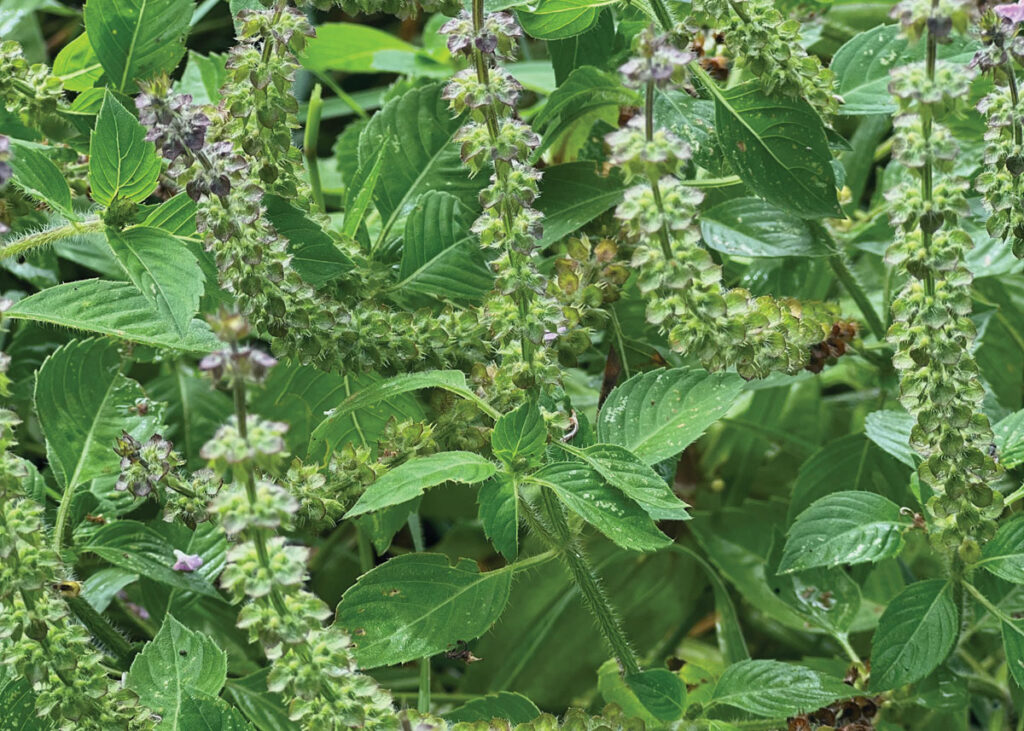
Medicinal Plants from the Garden: Tulsi, the Queen of Herbs

By Brittany P. Anderson
“Ooh, what is this? Is it mint or basil or?” a farm visitor asks after brushing against the mystery herb.
“That’s tulsi, holy basil,” I exclaim while rustling the leaves again, sending the perfumey aroma into the air around us.
Tulsi, also known as holy basil, Ocimum tenuiflorum, belongs to the mint family of perennial herbs and shrubs known for their aromatic scent. Notable, tulsi cousins include lavender, rosemary, sage, and sweet basil. Thought to have originated in north-central India, it now grows native throughout the eastern tropics. Tulsi is the most versatile medicinal herb for the home garden because it is a remedy for the body, mind, and spirit, from leaves to seeds.
A cup of tulsi tea a day might just be the thing to keep the doctor away. As with any remedy, always consult your primary care provider before adding tulsi to your medicine cabinet. Scientific evidence is beginning to prove the mechanism of effectiveness of ancient medicinal practices, including that of holy basil.
Tulsi is an adaptogen that helps the body adapt and recover from stress. Evidence shows it shields organs from chemical, physical, and pollutant stresses while also keeping blood sugars, blood pressure, and lipids (fat) stable.
Of all the uses of holy basil, its broad antimicrobial powers make it a popular herb for modern times. It has been shown to fight off animal and human pathogens and effectively reduce viral fevers.
Helping the body cope with stress, fighting off viral fevers, and keeping the body free from contaminants barely scratches the surface of this powerful herb. It is also incredibly easy to propagate in Hawai‘i.
Tulsi can be grown from seed or cuttings. It enjoys warm tropical weather yet also does well as a house plant in cooler climates. When planting from seed, soil temperatures need to be around 70˚F for successful germination. Tulsi seeds enjoy evenly moist fertile soil to start and thrive in full to partial sun. Regularly adding compost to the garden bed will help your holy basil flourish.
To start from a cutting, use sharp pruning shears and cleanly cut a stem from an established plant. Remove almost everything from the stalk, including flowers and most leaves, then place it in a glass of water in a sunny location. Change the water every other day to avoid mold and rot. You should see roots forming in a few weeks and little green leaves sprouting. Now you can transplant it into a good potting mix and then into the garden a few weeks later.
Unlike other basil varieties that become bitter after blooming, holy basil continues to blossom, retaining its sweet mint-like aroma and flavor. It has tiny purple flowers near constantly that provide excellent forage for bees.
Tulsi is a carefree shrub once established. It can grow to be one to two feet in height and circumference with routine trimming. In India, it is known to grow to be five feet tall in the heat of summer. Because tulsi can be grown year-round in Hawai‘i, it’s good to regularly harvest small amounts to promote continued growth. Pinching off early flower heads encourages the plant to form into a bush.
There are three main varieties of tulsi, all of which possess deep medicinal qualities. Rama tulsi is the most common holy basil found on Hawai‘i Island; it has green leaves, purple flowers, and a mellow minty clove-like flavor. Krishna tulsi is a rare purple-leafed plant, a slower-growing variety that produces a spicy, more concentrated flavor. There’s also Vana tulsi, which has darker green leaves at the base of the plant and lighter green at the top with a unique lemony flavor quality.
The most common way to use tulsi is by making it into tea. It is also lovely as a cut flower by the bedside. Brush your hand over the bouquet to release the stress-relieving fragrance before bed.
Make tulsi tea by steeping about a tablespoon of the herb, flowers, and leaves in one cup near-boiling water for 15 minutes. Be careful not to use boiling hot water as you will not get much flavor out of the leaves. Strain and enjoy with a bit of local honey. ❖



